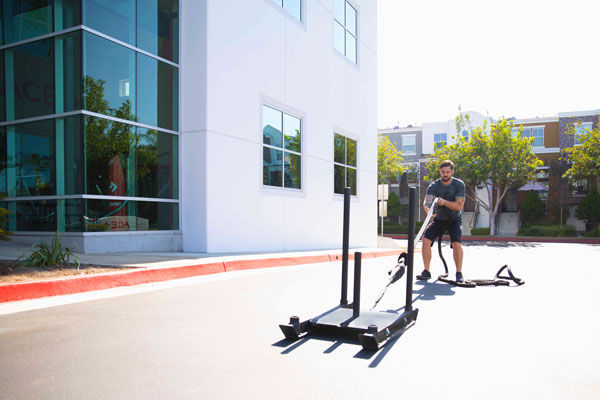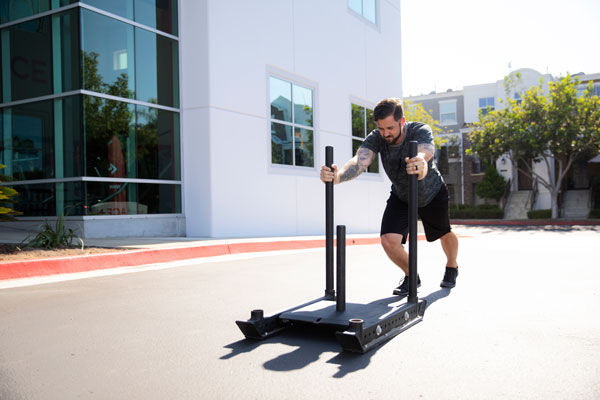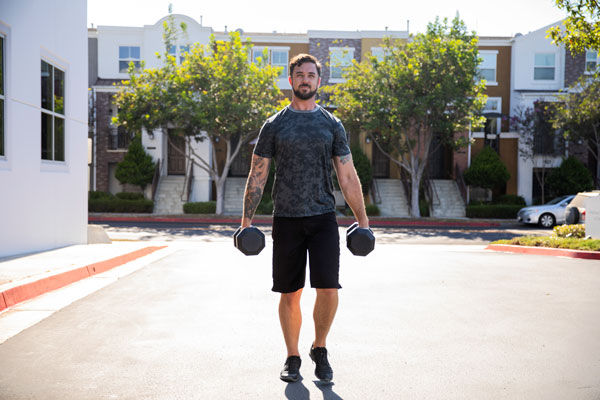Most people think strongman exercises are just about extreme heavy lifting, which isn’t surprising given the types of exercises associated with these competitions, such as deadlifting various objects and carrying them over a distance, pushing and pulling various items, and pressing things overhead. All of these types of movements, however, can be modified to suit your typical fitness client. Check out the following exercises, which can be a fun way to add a strongman twist to your clients’ exercise programs to keep them engaged and getting stronger.
One-arm Push Press
Typically performed with a large “circus” dumbbell in competitions, the one-arm press presents a unique core challenge for clients and an opportunity to teach proper core bracing techniques.


Technique:
- Stand with the feet shoulder-width apart, holding a dumbbell in front of the shoulder with a neutral grip. The elbow should be directly under the dumbbell.
- Brace through the legs, glutes and abdominal muscles.
- Initiate a quick dip or countermovement through the hips and legs as if you’re preparing to jump to begin accelerating the dumbbell.
- Follow through and press the weight into lockout overhead. Do not allow the torso to bend laterally or extend.
- Lower the dumbbell with control to the initial neutral position in front of the shoulder. Dip with the hips and legs again to softly bring the weight back into place.
Additional tips: Teaching clients to squeeze and flex through the free arm helps them to brace the core and transfer power to the dumbbell.
Arm-over-arm Pulling
Arm-over-arm pulling exercises target the muscles of the upper back and grip. They also train the core and hips to brace and resist rotation.

Technique:
- You can pull a sled or use a training partner as resistance. Begin by standing over the end of a battling rope that is attached to an object at the opposite end.
- Bend the knees and hinge forward slightly. Brace the core and pull any slack out of the rope with both hands.
- Begin pulling the rope with one hand while reaching out to grab the rope farther along with the other.
- Alternate hands until the object or person has passed a set distance or you run out of rope to pull.
Additional tips: Modify this exercise by changing the set-up from a standing to a tall kneeling, half kneeling or seated position.
Pushing and Dragging
Not everyone needs to push a truck or pull an airliner. These types of movements are often relegated to conditioning work, but short, heavy sets are a great tool for individuals who may not have the mobility for other movements. These movements require very little eccentric loading, so clients may not experience as much soreness as they would with other lower-body strength exercises.

Technique:
- Brace the core as you would for a squat or deadlift.
- Whether pushing forward or dragging backward, begin slowly and smoothly accelerate.
- Encourage clients to keep a constant stepping rhythm for a set duration or distance.
Additional tips: If your facility lacks sleds, clients can push each other by squatting back to back or placing their hands on each other’s shoulders. In this case, the participant providing resistance experiences more eccentric loading.
Farmer’s Walk
Picking up things and carrying them for distance or time builds functional strength. The farmer’s walk increases work capacity, core strength and grip. This truly functional exercise will help prepare clients for heavier lifting in all other exercises.

Technique:
- Deadlift a pair of dumbbells or kettlebells from the floor into a tall standing position.
- Keep the midsection braced with the rib cage down and begin walking for a set distance or time.
- Instruct clients to continue to breathe while walking and maintaining good posture.
Additional Tips: When space is limited, marching in place challenges the core, shoulders and grip.




 by
by 











 by
by